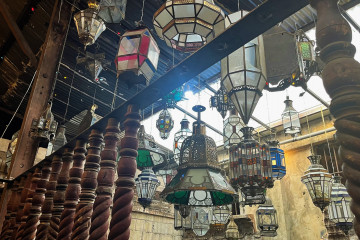

For much of his career, Lebanese multi-disciplinary artist Alfred Tarazi has sought to examine and interrogate his country’s complex relationship with history and heritage.
In his latest exhibition, Hymne a l’Amour (or ‘The Hymn of Love’), Alfred explores his own connection to Lebanon’s traditional craftsmen, using elements taken from his own family’s collection of artefacts to showcase the talents of these increasingly vanishing and forgotten artisans.
“It's a family inheritance,” Tarazi told The New Arab. “I come from a family of craftsmen, over four generations. We made tin; oriental crafts; woodwork. And we were also antique dealers, not only manufacturers.”
"This legacy has had to persist through extremely difficult times, both in the past and recently. Nevertheless, the Tarazis have always found a way to rebuild and continue to pass on their skills to a new generation"
“What we're showing is this very difficult negotiation with modernity,” he continued. “All of these objects are literally pre-modern, in an industrial sense. If you're a designer or an architect, or an artist, it's a fantastic study, because it's an extremely intelligent [form] of craft-making.”
Part of the Institut Français du Liban’s Art & Territory Program – in partnership with UMAM Documentation and Research, the Lebanese Ministry of Culture and the General Directorate of Antiquities (DGA) – the exhibition is divided into two parts.
The first part is a large-scale installation displayed on the steps of the National Museum of Beirut. Here, Tarazi has fashioned a scale reproduction of the exterior of the Residence de Pins (or ‘The Pine Residence’). Built in 1916, this official residence of the French Ambassador to Lebanon holds particular historic significance, both to the country of Lebanon and to Tarazi personally.
“One of the key objects that we're displaying is the model of the door of the [Residence de Pins],” he explained. “My great-grandfather did all the woodwork for that door.”
“That door is important because – in front of that door, in 1920 – General Henri Gouraud proclaimed the creation of the state of Greater Lebanon,” he continued. “The ‘mother’ of that door is an object of high cultural significance. It both carries the weight of the craft [and] the historical weight that rests upon it.”
The second part is a collection containing several thousand of the Tarazi family’s own handmade decorations and other items. These include brass and copper metalwork coffee jugs and bowls, geometric Baghdadi ceiling tiles, colourful glass lanterns, carved wooden doorframes and panels, salon furniture and bannister pieces.
Many have deteriorated while held in storage over the years. This reflects a wider trend – not just in Lebanon, but across the Middle East – where cultural preservation has gone largely passed over until comparatively recently.
“All these objects were in a warehouse, rotting gently, or not so gently,” said Tarazi. “It was a matter of responsibility for me to try to preserve and showcase these objects.”
“These are objects of high cultural significance [but they have] been overlooked in the local museology,” he explained. “While these kinds of crafts have been celebrated in Western museums, under the label of either decorative arts or Islamic art, there has been a general neglect [of] this heritage.”
The Tarazi family are prolific artisans, following a crafting tradition going back as far as the mid-1800s when – in 1862 – Tarazi’s great-grandfather, Dimitri Tarazi, founded Maison Tarazi, a gallery and manufacturing company of silks, carpets, antique metalcrafts and oriental furniture in Beirut.
Many of their works can be found on display in heritage buildings across Lebanon, including Sursock Palace, Villa Linda Sursock and the Sursock Museum, along with hundreds of other Ottoman-era houses across the MENA region.
This legacy has had to persist through extremely difficult times, both in the past and recently. Nevertheless, the Tarazis have always found a way to rebuild and continue to pass on their skills to a new generation.
“[My] grandfather's store was destroyed by the Civil War,” said Tarazi. “[My uncle's] store went through an explosion in Brummana, and then he opened [another] store in Mar Mikhael and that was devastated by the August 4 blast. We're going from one catastrophe to the other, trying to survive [and] to preserve this heritage.”
The family is still carrying on their work today. Camille Tarazi, who also currently manages the modern Maison Tarazi, has even joined the ongoing restoration of Sursock Palace, specifically the repair and replacement of the doors and other woodwork elements – also originally crafted by the Tarazis – that suffered damage due to the Beirut Port explosion.
|
The modern market for these traditional crafts has diminished in recent times. This has led to a decline in the number of practising crafters and a loss of many of these traditional skills, and the Lebanese economic crisis has exacerbated the situation even further as remaining crafters are forced into other areas of work to make ends meet.
“It is both fashion and the obsolescence of these crafts where there is no longer a local patronage,” said Tarazi. “They're expensive, they're time-consuming and the raw material is also expensive. All of that amounts to a craft that needs patronage in order to survive and that patronage has waned.”
“A lot of people are trying to revitalise [and] preserve crafts,” he added. “What we need is a more concerted effort, so that the various bodies that are working in cultural preservation and heritage can be in dialogue with each other, to [share] what the others know. [We] also need to be able to display such objects in museums or other institutions, [so that] people can learn about them.”
Although Tarazi remains optimistic and driven despite the adversity Lebanese traditional crafts face, he is also realistic when it comes to the question of who must bear the greater responsibility for the preservation of both these traditions and the artefacts they have produced.
“Honestly, I would much rather work within the private sector, given the current state of things,” he concluded. “I think that's how we can help today. Of course, it has to be cooperation with the state, but you cannot expect a bankrupt [government] to come up with anything.”
Robert McKelvey is a British freelance journalist and culture writer based in Lebanon.
Follow him on Twitter: @RCMcKelvey





 Follow the Middle East's top stories in English at The New Arab on Google News
Follow the Middle East's top stories in English at The New Arab on Google News


